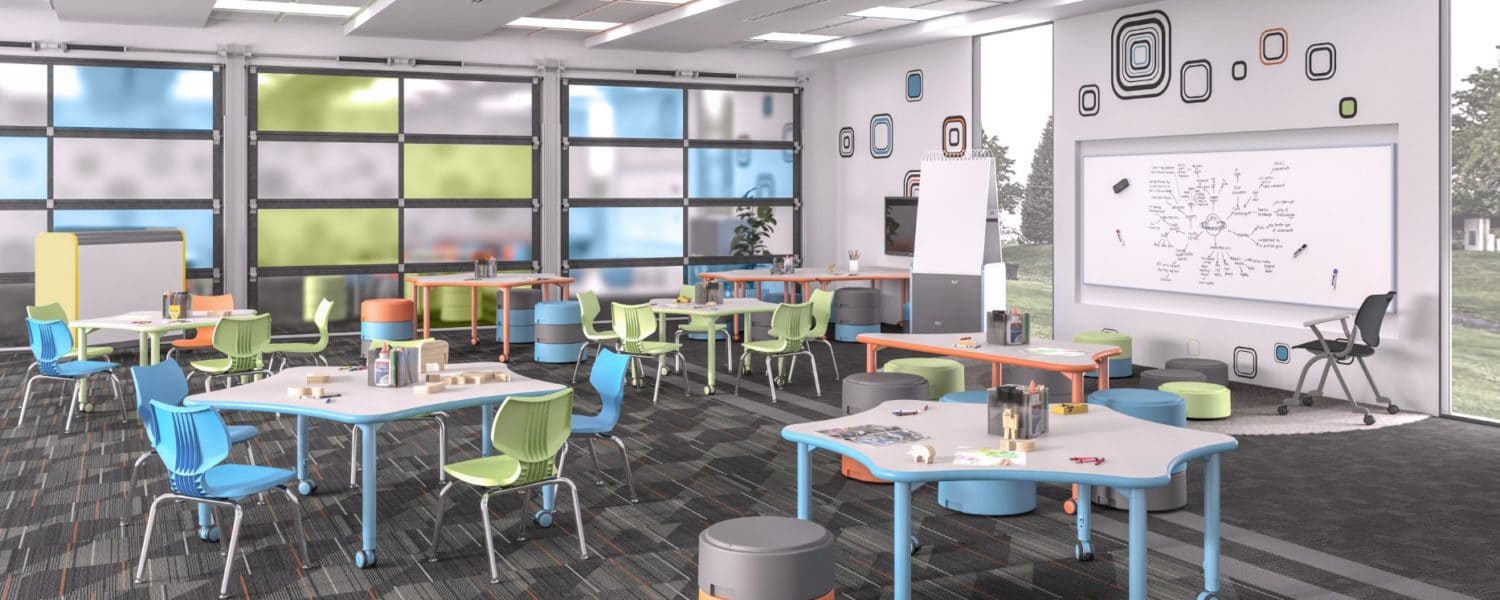By Cindy Eggebrecht
The way the furniture in a classroom is designed and configured can have a significant effect on how students learn, research suggests—and if you want students to engage in more active learning by working together to solve problems collaboratively, you can actually encourage those behaviors with how you arrange the desks and tables in the room.
How a classroom space is designed influences the types of learning activities that occur there, writes Nancy Van Note Chism for the higher-education technology advocacy group EDUCAUSE.
For example, “A room with rows of tablet arm chairs facing an instructor’s desk in front of chalkboards conveys the pedagogical approach: ‘I talk or demonstrate; you listen or observe,’” she writes. On the other hand, “A room of square tables with a chair on each side conveys the importance of teamwork and interaction to learning.”
Arranging desks or tables so that students are facing the teacher at the front of the room works well for direct instruction, because it focuses students’ attention on what the teacher has to say.
Arranging desks or tables in a large circle or “U” shape makes whole group discussion easier, because every student can see every other student in the class.
Arranging desks or tables in small groups, with three or four students facing each other, facilitates small group interaction and collaboration.
Because there will be times when teachers will want to use each of these strategies in their classrooms, flexibility is key when designing learning spaces, Van Note Chism observes.
“A group of learners should be able to move from listening to one speaker (traditional lecture or demonstration) to working in groups (team or project-based activities) to working independently (reading, writing, or accessing print or electronic resources),” she writes. “While specialized places for each kind of activity…can accommodate each kind of work, the flow of activities is often immediate. It makes better sense to construct spaces capable of quick reconfiguration to support different kinds of activities [using] moveable tables and chairs, for example.”
Classroom Design’s Impact on Learning
A recent study by the University of Salford in England confirmed that classroom design can have a 25% impact, either positive or negative, on a student’s progress over the course of an academic year—and flexibility (defined as how easily a classroom’s furniture can be rearranged for a variety of activities) was one of six key environmental factors that showed the most effect.
Arranging classroom desks or tables in ways that make it easy for students to pair off or work together in small groups not only supports active learning more readily—it also encourages this very behavior among students, while making it more likely that teachers will use active learning strategies during their instruction.
In a 2012 study at the University of Minnesota, research fellow D. Christopher Brooks observed two sections of a single course taught by the same instructor, with one section meeting in a traditional classroom space and the other meeting in a classroom designed for active learning. He found that both the instructor and the students behaved differently and engaged in classroom activities differently, depending on the type of classroom they were meeting in.
The traditional classroom had rows of tables facing the front of the room, while the active learning classroom was modeled after classrooms from North Carolina State University’s Student-Centered Activities for Large Enrollment Undergraduate Programs (SCALE-UP) initiative. In these classrooms, students were seated at large round tables that each hold nine students, making it easy for them to break off into groups of three for collaborative work.
Students in the active learning classroom—who had significantly lower ACT scores, on average—overcame the predicted achievement gap to earn the same average grade as their peers in the traditional classroom setting.
Even more significantly, how each space was arranged affected the kinds of activities that occurred there—despite the fact that the instructor took great pains to use the same teaching methods and materials.
For instance, lecturing occurred in 77.4% of the observational periods in the traditional classroom setting and only 54.5% of the periods in the active classroom setting.
Class discussions occurred in 48% more of the observational periods in the active learning classroom than in the traditional classroom.
What’s more, the instructor was at the podium in the front of the traditional classroom during 95.1% of the observational periods; in the active learning classroom, he was at the centrally located podium only 69.2% of the time.
Conversely, the instructor was not at the podium in 89.3% of all recorded intervals in the active learning classroom, compared to just 31.1% in the traditional setting.
The instructor also consulted privately with individual students or small groups of students twice as often in the active learning classroom (54.9%) than in the traditional classroom (27.4%).
Brooks concludes that:
- Space shapes instructor behavior and classroom activities
- Instructor behavior and classroom activities shape on-task student behavior
- Space shapes on-task student behavior
In particular, he notes, “Different classroom types are conducive to different outcomes.”
The Bottom Line
As long as your students are engaged in their learning, there are no “right” or “wrong” answers when it comes to arranging classroom furniture.
Choose flexible classroom furniture that can be rearranged easily to support different types of activities, let the kinds of learning you want to encourage be your guide, and don’t be afraid to change the configuration of the room to support the kinds of activities you are leading.
Cindy Eggebrecht is the director of marketing for Paragon Furniture, www.paragoninc.com. Since 1985, Paragon Furniture Inc., headquartered in Arlington, Texas, has set the pace and place for learning through the creation of high quality, affordable, eco-friendly furniture for use throughout entire K-12 educational environments.

















